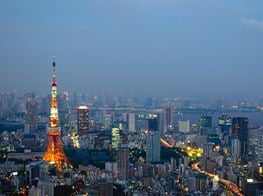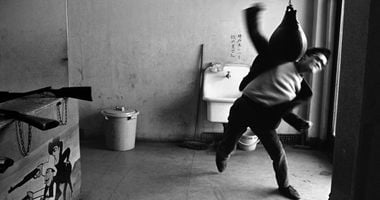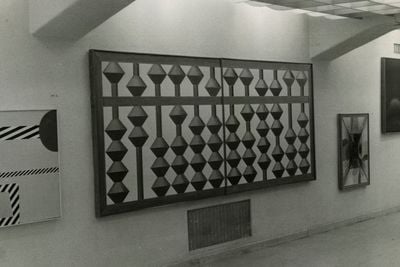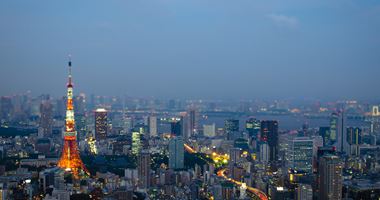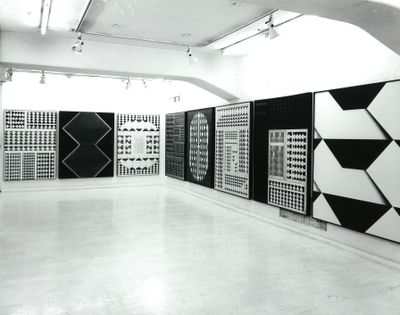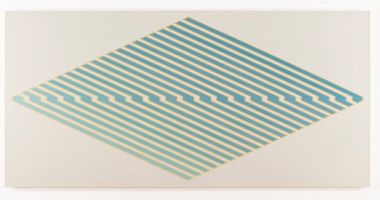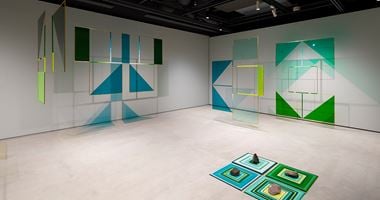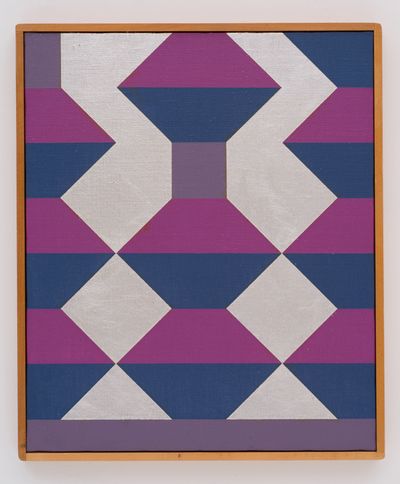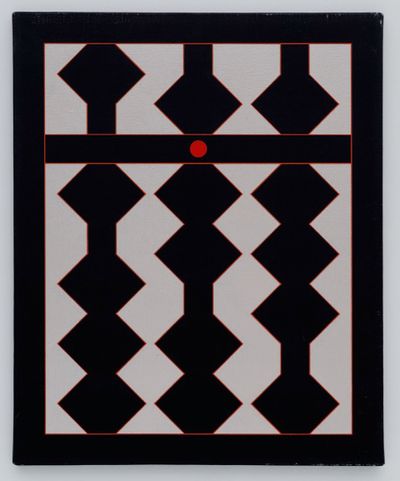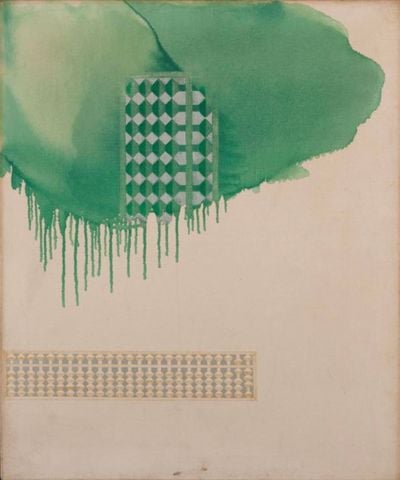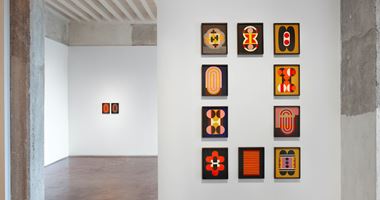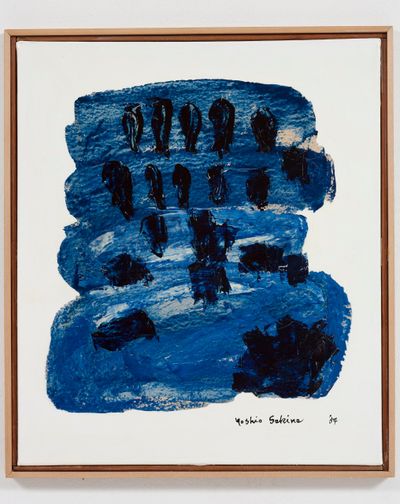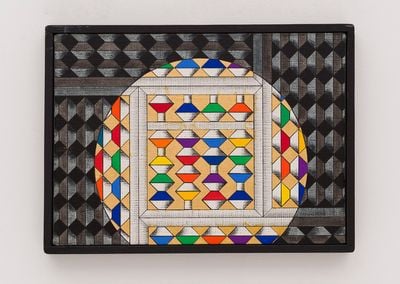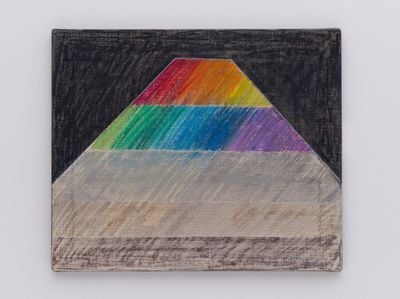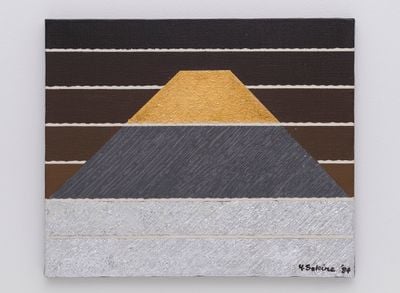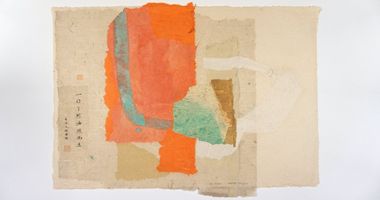Yoshio Sekine’s Soroban Modernism
No one painted quite like Yoshio Sekine, a founding member of the Gutai Art Association in Japan, who saw in the abacus a form offering limitless compositional possibilities.
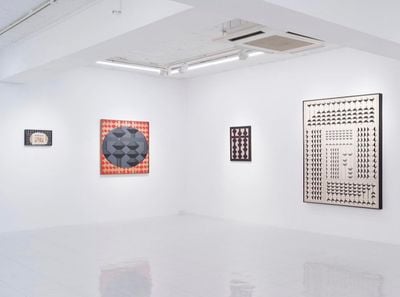
Exhibition view: Yoshio Sekine, Tokyo Gallery + BTAP, Tokyo (5 February—19 March 2022). Courtesy the Estate of Yoshio Sekine and Tokyo Gallery + BTAP.
It was apparently in 1963 at The 15th Yomiuri Independent Exhibition that Sekine first showed a painting of this ancient calculator—a few years after he left the Gutai group in 1959.
The design of the Japanese abacus, known as the soroban—vertical rods of diamond beads with a reckoning bar separating a single top bead with those below it—was used by Sekine to create perfect thresholds between figuration and hard-edge geometric abstraction.
The painting included in the 1963 show is a quintessential Sekine take on soroban, in which variations of the counting tray become a basic unit for block geometries.
One such painting appears in Tokyo Gallery + BTAP's solo review of Sekine's works (5 February–19 March 2022), the latest in a series of solo shows organised by the gallery since 1965.
In the black and tan No.388 (1975), a regular horizontal 13-rod line acts like the canvas' lintel up top, from which a vertical 15-line tray descends on its left side to meet a horizontal 11-rod block at the bottom, from which a ten-rod line rises up on the right.
These blocks circle a central tablet, where two eight-line trays are positioned to form a vertical rectangle alongside a single close-up frame composing the right segment: two rods only, two beads up and three beads down.
The range with which Sekine approached the abacus is striking. Whether in terms of numbers of rods used, colour combinations, and how beads were shaded.
Take No.509 (1982), a zoomed-in view of a bottom row, whose beads pop with block colours separated neatly by the diamond's middle horizon: fuchsia at the top and dark teal below.
Works like these lean in to abstraction, with No.479 (1978) showing a three-line tray over a silver-foil background, the abacus form painted in flat black with thin red outlines and a single red circle poised at the centre of a reckoning bar.
In Sekine's paintings, abstraction retains a clear connection to the real.
Other canvases employ paint with a lightness that recalls charcoal on paper, creating three dimensions in shaded brown tones, like one 1963 painting depicting a full calculator of six rods counting out 063020, invoking Brancusi's infinity column.
It's remarkable to compare that 1963 work with, say, Abacuses (1963), housed in the collection of The National Museum of Art in Osaka.
A single green vertical abacus emerging from a green wash appears like a dripping cloud at the top of an unprimed canvas. Below, a long, horizontally positioned calculator cuts across the frame in tones of tea over a grey ground.
That painting seems to portray Sekine's soroban modernism emerging from a more expressive style seen in earlier works like the oil on canvas GUTAI, painted the year the Gutai group was founded in 1954. A thick blue stroke snakes over the surface in four waves to create a ground on which vertical black marks tally a score.
The difference between Sekine's Gutai years and the clean, graphic expressions of the sorobans that followed are striking, with the simple calculating tool rendered in endless configurations—indeed, calculations—amounting to a unique minimalism.
In some cases, a magnifying glass or spotlight appears to have been placed over the composition—appearing either as a single circle, or at times the binocular view of two circles overlapping—creating an enlarged or enlightened section over a darker pattern. In No.449 (1978), a circular view of a bright, multicolour abacus pops out from a greyscale spread.
At Tokyo Gallery + BTAP, that painting recalls another on view, No.24 (1964), where rows of sorobans in neutral browns on the right half of the canvas contrast a musical score on the left, on which notes are coloured an array of bright, rainbow tones.
It's a visualisation of the musicality that punctuates Sekine's work. The very sight of an abacus is enough to recall the rhythmic tapping created by the tool's calculations, once so commonly heard across Asia, with each bead articulating at once beat and tone.
A sense of movement extends to other series Sekine that worked on following his departure from the expressive style he developed within the Gutai, which Tokyo Gallery + BTAP have included in their current mix. Beyond the abacus, Sekine used railway cars and Mount Fuji as vehicles for abstraction; the latter distilled into a triangle with a lighter peak.
In the oil on canvas Mt.57 (1983), Mount Fuji appears against a black background, its triangular form divided into neat rows filled with a rainbow gradation at the top descending to grey below, with oil-stick strokes appearing like crayon marks on paper.
The same composition appears again, this time with the mountain's rows executed with harder edges against a black-striped backdrop, with gold block at the top and grey down below, in Mt.130 (1984).
Sekine would often add gold leaf and aluminium foil to his compositions; a detail that would imbibe his pictures with a kind of serene, iconic reverence.
Both materials appear in No. 563 (1984), in which three abacus columns appear in a metallic greyscale of silver acrylic paint and aluminium foil, with a single circle at the centre of the reckoning row rendered in delicate gold leaf.
Such gestures set Sekine apart from contemporaries who turned to geometric shapes to express pure, modern form. In Sekine's paintings, abstraction retains a clear connection to the real. —[O]

